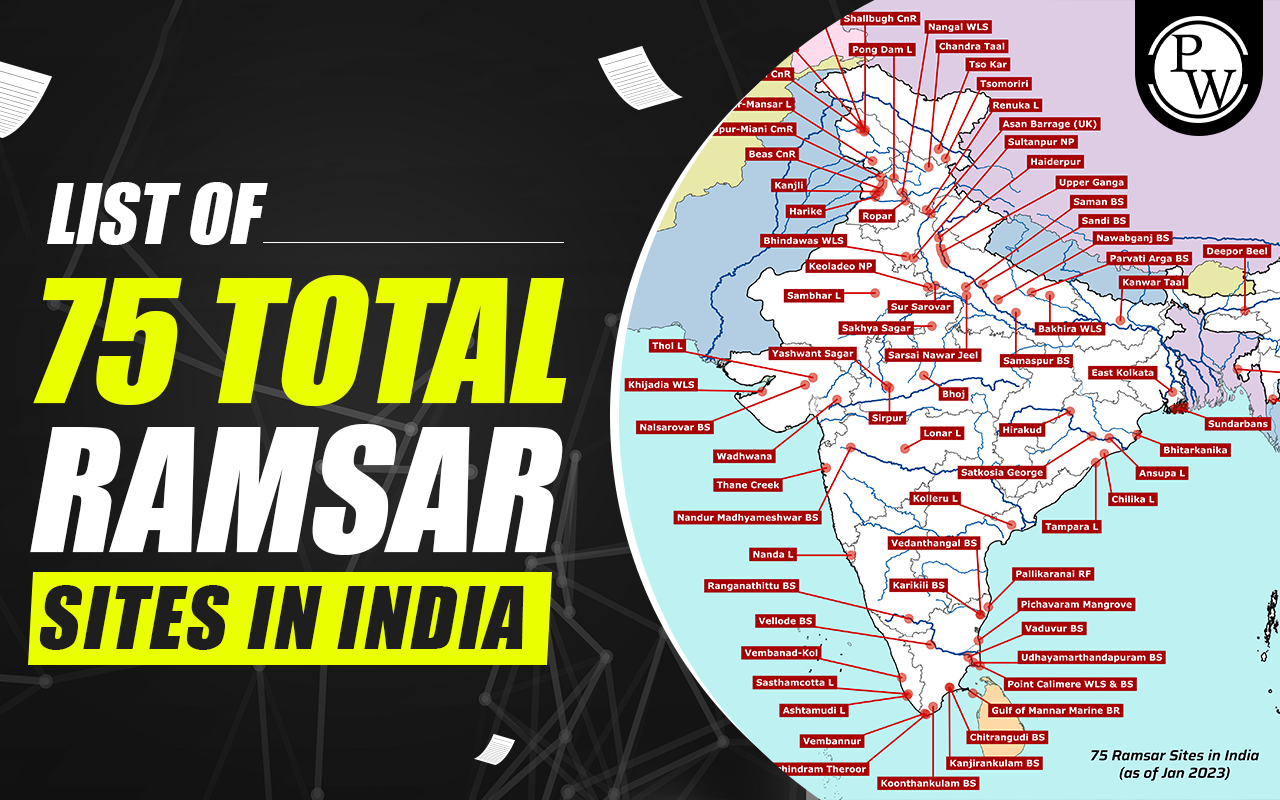

List of 75 Ramsar Sites in India: A Ramsar site, designated as a wetland of global significance, falls under the Ramsar Convention or 'Convention on Wetlands,' an international environmental treaty initiated by UNESCO in 1971. The treaty was named after Ramsar, Iran, where it was signed. Ramsar recognition primarily focuses on identifying wetlands worldwide that hold international importance, especially those providing critical habitat for waterfowl, encompassing approximately 180 bird species.
This recognition signifies an international commitment to conserving these wetlands and using their resources wisely. In India, the Sundarbans in West Bengal stand as the largest Ramsar site, covering about 11,000 square kilometers, which is approximately 10% of India's total wetland area, spanning across 18 states. India's extensive geographical diversity and tropical ecosystems contribute to its substantial number of Ramsar sites, surpassing other South Asian nations. India has many Ramsar Sites that are helping to protect the country's natural beauty and ensure a sustainable environment for future generations.
Ramsar Sites in India
India boasts a diverse array of Ramsar Sites, which are wetlands of international importance recognized under the Ramsar Convention, an environmental treaty initiated by UNESCO in 1971. These sites play a crucial role in preserving the nation's rich natural heritage. From the magnificent Sundarbans in West Bengal to the pristine wetlands of Chilika Lake in Odisha, these Ramsar Sites span 18 states, covering approximately 10% of India's total wetland area, which is about 11,000 square kilometers. They serve as significant habitats for numerous bird species, including waterfowl. The recognition of these sites underlines India's commitment to conserving its wetlands, promoting sustainable practices, and safeguarding these unique ecosystems for future generations.
List of Ramsar Sites of India [75 Ramsar Sites in India as of 2023]
India currently boasts a total of 75 Ramsar Sites, with eleven new wetland sites receiving Ramsar Site status last year. Among Indian states, Tamil Nadu leads the way with the highest number of Ramsar Sites, totaling 14. Between 1982 and 2013, India included 26 sites on the Ramsar list, but from 2014 to 2022, the nation expanded this list by incorporating an additional 49 wetlands. Interestingly, 28 of these sites received Ramsar recognition in 2022 alone. Furthermore, in August 2022, India celebrated its 75th year of independence by adding 11 more wetlands to the Ramsar list, collectively covering an area of 13,26,677 hectares across the country.
| Sr. No | Ramsar Site | State | Designated Year | Area (km2) |
| 1 | Kolleru Lake | Andhra Pradesh | 2002 | 901 |
| 2 | Deepor Beel | Assam | 2002 | 40 |
| 3 | Kanwar (Kabar) Taal | Bihar | 2020 | 26.2 |
| 4 | Nanda Lake | Goa | 2022 | 0.42 |
| 5 | Khijadia WLS | Gujarat | 2021 | 6 |
| 6 | Nalsarovar BS | Gujarat | 2012 | 123 |
| 7 | Thol Lake | Gujarat | 2021 | 6.99 |
| 8 | Wadhvana Wetland | Gujarat | 2021 | 10.38 |
| 9 | Bhindawas WLS | Haryana | 2021 | 4.11 |
| 10 | Sultanpur NP | Haryana | 2021 | 142.5 |
| 11 | Chandra Taal | Himachal Pradesh | 2005 | 0.49 |
| 12 | Pong Dam Lake | Himachal Pradesh | 2002 | 156.62 |
| 13 | Renuka Lake | Himachal Pradesh | 2005 | 0.2 |
| 14 | Ranganathituu BS | Karnataka | 2022 | 5.18 |
| 15 | Ashtamudi Wetland | Kerala | 2002 | 614 |
| 16 | Sasthamkotta Lake | Kerala | 2002 | 3.73 |
| 17 | Vembanad-Kol Wetland (Longest Lake in India) | Kerala | 1905 | 1512.5 |
| 18 | Bhoj Wetland | Madhya Pradesh | 2002 | 32 |
| 19 | Sakhya Sagar | Madhya Pradesh | 2022 | 2.48 |
| 20 | Sirpur wetland | Madhya Pradesh | 2022 | 1.61 |
| 21 | Yashwant Sagar | Madhya Pradesh | 2022 | 8.22 |
| 22 | Lonar Lake (Impact Crater Lake) | Maharashtra | 2020 | 4.27 |
| 23 | Nandur Madhameshwar | Maharashtra | 2019 | 14 |
| 24 | Thane Creek | Maharashtra | 2022 | 65.21 |
| 25 | Loktak Lake | Manipur | 1990 | 266 |
| 26 | Pala Wetland | Mizoram | 2021 | 18.5 |
| 27 | Ansupa Lake | Odisha | 2021 | 2.31 |
| 28 | Bhitarkanika Mangroves | Odisha | 2002 | 650 |
| 29 | Chilika Lake (Oldest Ramsar Site in India) | Odisha | 1981 | 1165 |
| 30 | Hirakud Reservoir | Odisha | 2021 | 654 |
| 31 | Satkosia Gorge | Odisha | 2021 | 981.97 |
| 32 | Tampara Lake | Odisha | 2021 | 3 |
| 33 | Beas CnR | Punjab | 2019 | 64 |
| 34 | Harike Wetland | Punjab | 1990 | 41 |
| 35 | Kanjli Wetland | Punjab | 2002 | 1.83 |
| 36 | Keshopur-Miani CmR | Punjab | 2019 | 34 |
| 37 | Nangal WLS | Punjab | 2019 | 1 |
| 38 | Ropar Wetland | Punjab | 2002 | 13.65 |
| 39 | Keoladeo National Park | Rajasthan | 1981 | 28.73 |
| 40 | Sambhar Lake | Rajasthan | 1990 | 240 |
| 41 | Chitrangudi BS | Tamil Nadu | 2021 | 2.6 |
| 42 | Gulf of Mannar Marine BR | Tamil Nadu | 2022 | 526.72 |
| 43 | Kanjirankulam BS | Tamil Nadu | 2022 | 0.96 |
| 44 | Karikili BS | Tamil Nadu | 2022 | 0.584 |
| 45 | Koonthankulam BS | Tamil Nadu | 2021 | 0.72 |
| 46 | Pallikaranai Marsh Reserve Forest | Tamil Nadu | 2022 | 12.475 |
| 47 | Pichavaram Mangrove | Tamil Nadu | 2022 | 14.786 |
| 48 | Point Calimere WLS & BS | Tamil Nadu | 2002 | 385 |
| 49 | Suchindram Theroor Wetland Complex | Tamil Nadu | 2022 | 0.94 |
| 50 | Udhayamarthandapuram BS | Tamil Nadu | 2022 | 0.44 |
| 51 | Vaduvur BS | Tamil Nadu | 2022 | 1.12 |
| 52 | Vedanthangal BS | Tamil Nadu | 2022 | 0.4 |
| 53 | Vellode BS | Tamil Nadu | 2022 | 0.77 |
| 54 | Vembannur Wetland Complex | Tamil Nadu | 2022 | 0.2 |
| 55 | Rudrasagar Lake | Tripura | 2005 | 2.4 |
| 56 | Hokera Wetland | UT of JK | 2005 | 13.75 |
| 57 | Hygam Wetland CnR | UT of JK | 2022 | 8.02 |
| 58 | Shallbugh Wetland CnR | UT of JK | 2022 | 16.75 |
| 59 | Surinsar-Mansar Lakes | UT of JK | 2005 | 3.5 |
| 60 | Wular Lake | UT of JK | 1990 | 189 |
| 61 | Tso Kar (High Altitude Ramsar Site) | UT of Ladakh | 2020 | 95.77 |
| 62 | Tsomoriri (High Altitude Ramsar Site) | UT of Ladakh | 2002 | 120 |
| 63 | Bakhira WLS | Uttar Pradesh | 2021 | 28.94 |
| 64 | Haiderpur Wetland | Uttar Pradesh | 2021 | 69 |
| 65 | Nawabganj BS | Uttar Pradesh | 2019 | 2 |
| 66 | Parvati Arga BS | Uttar Pradesh | 2019 | 7 |
| 67 | Saman BS | Uttar Pradesh | 2019 | 5 |
| 68 | Samaspur BS | Uttar Pradesh | 2019 | 8 |
| 69 | Sandi BS | Uttar Pradesh | 2019 | 3 |
| 70 | Sarsai Nawar Jheel | Uttar Pradesh | 2019 | 2 |
| 71 | Sur Sarovar (Keetham Lake) | Uttar Pradesh | 2020 | 4.31 |
| 72 | Upper Ganga River (Brijghat to Narora) | Uttar Pradesh | 2005 | 265.9 |
| 73 | Asan Barrage | Uttarakhand | 2020 | 4.44 |
| 74 | East Kolkata Wetlands | West Bengal | 2002 | 125 |
| 75 | Sundarban Wetland (Largest Ramsar Site in India) | West Bengal | 2019 | 4230 |
Statewise Number and Area of Ramsar Sites
India's Ramsar Sites are distributed across the country, with each state playing a crucial role in preserving its wetland treasures. Tamil Nadu leads the pack, hosting 14 Ramsar Sites, and covering a substantial area. These Sites span the nation, with each state contributing to the preservation of its unique wetland ecosystems. They serve as significant habitats for a large number of plant and animal species, play a role in flood control, and are significant for sustainable water management.
| Rank | State | No. of Ramsar Sites | Rank | State | Area Under Ramsar Sites (km2) | |
| 1 | Tamil Nadu | 14 | 1 | West Bengal | 4355 | |
| 2 | Uttar Pradesh | 10 | 2 | Odisha | 3456 | |
| 3 | Odisha | 6 | 3 | Kerala | 2130 | |
| 4 | Punjab | 6 | 4 | Tamil Nadu | 948 | |
| 5 | UT of JK | 5 | 5 | Andhra Pradesh | 901 | |
| 6 | Gujarat | 4 | 6 | Uttar Pradesh | 395 | |
| 7 | Madhya Pradesh | 4 | 7 | Rajasthan | 269 | |
| 8 | Kerala | 3 | 8 | Manipur | 266 | |
| 9 | Himachal Pradesh | 3 | 9 | UT of JK | 231 | |
| 10 | Maharashtra | 3 | 10 | UT of Ladakh | 216 | |
| 11 | West Bengal | 2 | 11 | Himachal Pradesh | 157 | |
| 12 | Rajasthan | 2 | 12 | Punjab | 156 | |
| 13 | UT of Ladakh | 2 | 13 | Haryana | 147 | |
| 14 | Haryana | 2 | 14 | Gujarat | 146 | |
| 15 | Andhra Pradesh | 1 | 15 | Maharashtra | 84 | |
| 16 | Manipur | 1 | 16 | Madhya Pradesh | 44 | |
| 17 | Assam | 1 | 17 | Assam | 40 | |
| 18 | Bihar | 1 | 18 | Bihar | 26 | |
| 19 | Mizoram | 1 | 19 | Mizoram | 19 | |
| 20 | Karnataka | 1 | 20 | Karnataka | 5.2 | |
| 21 | Uttarakhand | 1 | 21 | Uttarakhand | 4.4 | |
| 22 | Tripura | 1 | 22 | Tripura | 2.4 | |
| 23 | Goa | 1 | 23 | Goa | 0.42 | |
| 75 Ramsar Sites (as of Apr 2023) | ~14,000 km2 (as of Apr 2023) | |||||
10 interesting facts about Ramsar Sites of India
Let us look at the most interesting facts about Ramsar Sites of India:
- Sundarbans: The Sundarbans in West Bengal, India's largest Ramsar Site, spans about 11,000 square kilometers and stands as one of the most critical habitats for the Bengal tiger, a globally endangered species.
- Geographic Diversity: India's Ramsar Sites are incredibly diverse, ranging from high-altitude sites like Tso Kar and Tsomoriri in Ladakh to coastal sites like Chilika Lake in Odisha.
- Waterfowl Paradise: These sites are a haven for waterfowl, hosting around 180 species of birds, including flamingos, pelicans, and various migratory species.
- Dominance of Tamil Nadu: Tamil Nadu boasts the highest number of Ramsar Sites among Indian states, with a total of 14 sites, showcasing the state's commitment to preserving its wetland ecosystems.
- Ranganathittu Bird Sanctuary: Located in Karnataka, this Ramsar Site is a paradise for birdwatchers and home to diverse avian species, making it a must-visit for nature enthusiasts.
- The Ancient Keoladeo National Park: This Ramsar Site in Rajasthan, formerly known as Bharatpur Bird Sanctuary, has a rich history and is celebrated for its avian diversity, particularly during the winter migratory season.
- Pong Dam Lake: Situated in Himachal Pradesh, this Ramsar Site is a crucial stopover for numerous migratory birds traveling along the Central Asian Flyway.
- Urban Wetlands: Some Ramsar Sites are located in urban areas, like Thane Creek in Mumbai, showcasing the coexistence of nature and urban development.
- Contribution of Maharashtra: Maharashtra added significant wetlands to the Ramsar list in 2022, including the Lonar Lake, Thane Creek, and Nandur Madhameshwar.
- Record Growth: India added 49 new Ramsar Sites between 2014 and 2022, showcasing the nation's strong commitment to wetland conservation and protection.
List of 75 Total Ramsar Sites in India FAQs
Q1. What is a Ramsar Site?
Q2. How many Ramsar Sites are there in India?
Q3. Which state in India has the most Ramsar Sites?
Q4. Why are Ramsar Sites important?
Q5. What is the largest Ramsar Site in India?












